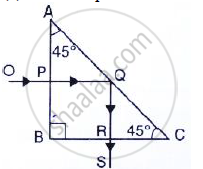Advertisements
Advertisements
Question
A ray of light of wavelength 6600 Å suffer refraction from air to glass. Taking \[\ce{_a\mu_g = \frac{3}{2}}\], find the wavelength of light in glass.
Solution
We know that V = f λ
air μ glass = `"Velocity in vacuum or air"/"Velocity in glass"`
`3/2 = (f "air" xx λ "air")/(f "glass" xx λ "glass")`
However, light's frequency does not change as it refracts.
∴ f air = f glass
∴ `3/2 = (λ "air")/(λ "glass")`
λ glass = wave length in glass = `2/3 λ` air
λ glass = `2/3 xx 6600`
= 4400 Å
APPEARS IN
RELATED QUESTIONS
If the speed of light in vacuum is 3 × 108 ms−1, find the speed of light in a medium of absolute refractive index 1.5.
A ray of light OP passes through a right angles prism as shown in the adjacent diagram.
(a) State the angles of incidence at the faces AC and BC.
(b) Name the phenomenon which the ray suffers at the face AC.

Which of the following is the best experimental set-up out of the four shown for tracing the path of a ray of light passing through a rectangular glass slab ?
Name the phenomenon responsible in the following case:
Apparent bending of a stick in water
Glass is transparent in nature. Why does glass powder look opaque? When water is poured over it, it again becomes transparent. Why?
Why is the colour red used as a sign of danger?
Does the depth of a tank of water appear to change or remain the same when viewed normally from above?
What is the refractive index of vacuum
What do you understand by the deviation produced by a prism?
The refractive index of glass with respect to air is 3/2. What is the refractive index of air with respect to glass?
